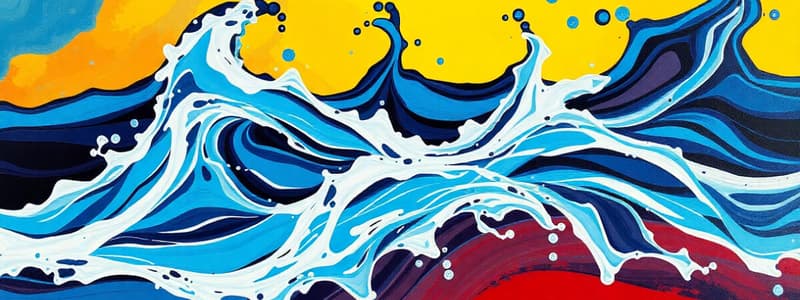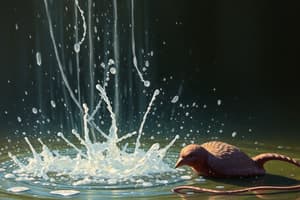Podcast
Questions and Answers
เมื่อเรือใบแล่นออกจากชายฝั่งในตอนเช้าตรู่ ลมชนิดใดที่มีแนวโน้มจะช่วยให้เรือแล่นได้ดีที่สุด และเหตุใด
เมื่อเรือใบแล่นออกจากชายฝั่งในตอนเช้าตรู่ ลมชนิดใดที่มีแนวโน้มจะช่วยให้เรือแล่นได้ดีที่สุด และเหตุใด
- ลมทะเล เพราะอุณหภูมิของน้ำทะเลสูงกว่าอุณหภูมิของพื้นดิน
- ลมทะเล เพราะอุณหภูมิของพื้นดินสูงกว่าอุณหภูมิของน้ำทะเล
- ลมบก เพราะอุณหภูมิของน้ำทะเลสูงกว่าอุณหภูมิของพื้นดิน
- ลมบก เพราะอุณหภูมิของพื้นดินสูงกว่าอุณหภูมิของน้ำทะเล (correct)
หากคุณสังเกตเห็นว่าความดันอากาศลดลงอย่างรวดเร็ว สถานการณ์ใดต่อไปนี้มีแนวโน้มที่จะเกิดขึ้นตามมา
หากคุณสังเกตเห็นว่าความดันอากาศลดลงอย่างรวดเร็ว สถานการณ์ใดต่อไปนี้มีแนวโน้มที่จะเกิดขึ้นตามมา
- ลมสงบและอุณหภูมิคงที่
- พายุฝนฟ้าคะนองและลมกระโชกแรง (correct)
- หมอกลงจัดในตอนเช้า
- ท้องฟ้าโปร่งและอากาศแจ่มใส
สมมติว่าคุณกำลังฟังเพลงจากลำโพงที่อยู่ห่างออกไป 10 เมตร หากคุณเพิ่มระดับเสียง (ความดัง) ของลำโพง ปัจจัยใดต่อไปนี้ที่จะเปลี่ยนแปลง
สมมติว่าคุณกำลังฟังเพลงจากลำโพงที่อยู่ห่างออกไป 10 เมตร หากคุณเพิ่มระดับเสียง (ความดัง) ของลำโพง ปัจจัยใดต่อไปนี้ที่จะเปลี่ยนแปลง
- ความเร็วของเสียง
- ความยาวคลื่นของเสียง
- ความถี่ของเสียง
- แอมพลิจูดของคลื่นเสียง (correct)
เมื่อนักดำน้ำลงไปในทะเลลึก ความดันน้ำที่กระทำต่อนักดำน้ำจะเปลี่ยนแปลงอย่างไร และปัจจัยใดเป็นตัวกำหนดการเปลี่ยนแปลงนี้
เมื่อนักดำน้ำลงไปในทะเลลึก ความดันน้ำที่กระทำต่อนักดำน้ำจะเปลี่ยนแปลงอย่างไร และปัจจัยใดเป็นตัวกำหนดการเปลี่ยนแปลงนี้
เครื่องดนตรีชนิดใดต่อไปนี้ที่สามารถเปลี่ยนระดับเสียง (ความสูงต่ำ) ของเสียงได้โดยการเปลี่ยนความยาวของแหล่งกำเนิดเสียง
เครื่องดนตรีชนิดใดต่อไปนี้ที่สามารถเปลี่ยนระดับเสียง (ความสูงต่ำ) ของเสียงได้โดยการเปลี่ยนความยาวของแหล่งกำเนิดเสียง
Flashcards
ความดันอากาศคืออะไร
ความดันอากาศคืออะไร
แรงที่อากาศกระทำต่อหนึ่งหน่วยพื้นที่
ความดันน้ำคืออะไร
ความดันน้ำคืออะไร
แรงที่น้ำกระทำต่อหนึ่งหน่วยพื้นที่
เสียงคืออะไร
เสียงคืออะไร
การสั่นสะเทือนที่เดินทางผ่านตัวกลาง
แหล่งกำเนิดเสียงคืออะไร
แหล่งกำเนิดเสียงคืออะไร
Signup and view all the flashcards
ลมบกคืออะไร
ลมบกคืออะไร
Signup and view all the flashcards
Study Notes
- Air pressure is the force exerted by the weight of air on a surface.
- Air pressure is typically measured in units of pascals (Pa) or millibars (mb).
- Air pressure decreases with increasing altitude.
- Water pressure is the force exerted by water on a surface.
- Water pressure increases with depth.
- Water pressure acts equally in all directions.
- Sound is a form of energy that travels in waves through a medium.
- Sound is produced by vibrations.
- Sound can travel through solids, liquids, and gases.
- A source of sound is any object that vibrates and produces sound waves.
- Examples of sound sources include musical instruments, human voices, and loudspeakers.
- The frequency of a sound wave determines its pitch or tone.
- Wind is the movement of air caused by differences in air pressure.
- Wind always blows from areas of high pressure to areas of low pressure.
- Wind generation refers to the process of using wind turbines to convert the kinetic energy of wind into electrical energy.
- Wind turbines typically consist of a rotor with blades that spin in the wind, a generator that converts the mechanical energy of the spinning rotor into electrical energy, and a tower that supports the rotor and generator.
- A land breeze is a local wind that blows from land to sea during the night.
- Land breezes occur because land cools down faster than water at night.
- The cool air over the land creates an area of high pressure, while the warmer air over the sea creates an area of low pressure, causing wind to blow from the land to the sea.
- A sea breeze is a local wind that blows from sea to land during the day.
- Sea breezes occur because land heats up faster than water during the day.
- The warm air over the land creates an area of low pressure, while the cooler air over the sea creates an area of high pressure, causing wind to blow from the sea to the land.
Types of Wind
- Global winds are large-scale wind systems that are caused by the unequal heating of the Earth's surface by the sun.
- Examples of global winds include the trade winds, the westerlies, and the polar easterlies.
- Local winds are small-scale wind systems that are influenced by local geographic features such as mountains, valleys, and bodies of water.
- Examples of local winds include sea breezes, land breezes, and mountain and valley breezes.
- Prevailing winds are the most frequent or common winds in a particular location.
- The prevailing winds can affect the climate and weather patterns of a region.
Sound Movement
- Sound waves propagate through a medium by causing the particles of the medium to vibrate.
- Sound waves can be reflected, refracted, and diffracted.
- The speed of sound depends on the properties of the medium through which it is traveling.
- Sound travels faster in solids than in liquids or gases.
- Sound travels faster in warmer temperatures than in cooler temperatures.
Complex Problem: Determining the Optimal Placement of a Wind Turbine
- A town located near a coastline wants to install a wind turbine to generate electricity. The challenge is to determine the optimal location for the wind turbine to maximize energy production, considering factors such as land and sea breezes, types of wind, and air pressure variations.
Applying Concepts to Solve the Problem
- Analyze the local wind patterns:
- Collect data on the prevailing winds, including their speed and direction, throughout the year.
- Investigate the influence of land and sea breezes on the wind patterns near the coastline.
- Determine if there are seasonal variations in wind patterns.
- Consider air pressure and temperature:
- Monitor air pressure variations to understand how they affect wind speed and direction.
- Assess temperature differences between the land and sea, as these differences drive land and sea breezes.
- Evaluate potential locations:
- Identify candidate locations for the wind turbine based on wind data and proximity to the town's electrical grid.
- Use weather models to simulate wind flow patterns around potential locations, considering obstacles like hills or buildings.
- Calculate energy production:
- Estimate the energy production potential of each candidate location based on the modeled wind speeds and the turbine's specifications.
- Factor in potential downtime due to maintenance or extreme weather conditions.
- Environmental and social impact:
- Assess the environmental impact of each location, including effects on wildlife, noise pollution, and visual impact.
- Consider social factors such as proximity to residential areas and community acceptance.
- Optimize the placement:
- Use a decision-making framework to weigh the costs and benefits of each location, considering energy production, environmental impact, and social factors.
- Select the location that maximizes energy production while minimizing negative impacts.
Studying That Suits You
Use AI to generate personalized quizzes and flashcards to suit your learning preferences.




